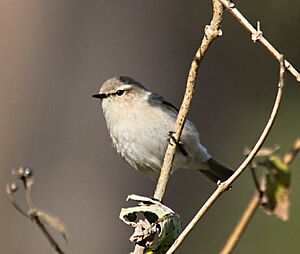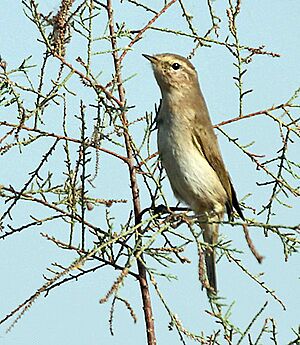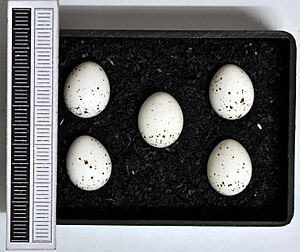Common chiffchaff facts for kids
Quick facts for kids Common chiffchaff |
|
|---|---|
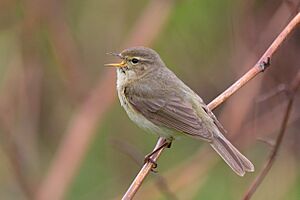 |
|
| Conservation status | |
| Scientific classification | |
| Genus: |
Phylloscopus
|
| Species: |
collybita
|
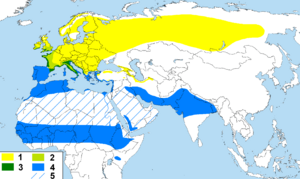 |
|
|
|
The common chiffchaff (Phylloscopus collybita), often just called the chiffchaff, is a small, common leaf warbler. It lives in woodlands across northern and temperate Europe and Asia.
This bird is a migratory passerine (a type of perching bird). It spends its winters in southern and western Europe, southern Asia, and northern Africa. Chiffchaffs are greenish-brown on top and off-white underneath. They get their name from their simple chiff-chaff song. This name is an example of onomatopoeia, where a word sounds like what it describes.
Female chiffchaffs build a dome-shaped nest on or near the ground. They do most of the work raising the chicks. The male helps by defending his territory from other birds and predators. Chiffchaffs eat mostly insects. They can be hunted by animals like cats and weasels, and by birds like hawks. Luckily, there are many chiffchaffs, so they are not in danger.
Contents
What is a Chiffchaff?
The common chiffchaff is a small, plump leaf warbler. It is about 10 to 12 centimeters (4 to 5 inches) long. Males weigh about 7–8 grams (0.28–0.31 ounces), and females are a bit lighter at 6–7 grams (0.25–0.28 ounces).
Adult chiffchaffs in spring have dull green-brown upperparts. Their undersides are off-white, turning yellowish on their sides. They have a short, whitish stripe above their eye, called a supercilium. They also have dark legs and a thin, dark beak. After the breeding season, their feathers get duller. But after they molt (shed their old feathers), they become brighter and greener again. Young chiffchaffs are browner than adults when they first hatch.
Why is it Called a Chiffchaff?
This warbler is named after its simple, cheerful song: a repeated chiff-chaff. This song is one of the first signs that spring has arrived! Its call is a hweet.
The chiffchaff's English name comes from its song. Many other European languages have similar names, like the Dutch tjiftjaf or the German Zilpzalp. The scientific name, Phylloscopus collybita, comes from Greek words. Phylloscopus means "leaf-looker," because these birds spend a lot of time looking for food in trees. Collybita means "money changer," because their song sounds like coins jingling!
How to Tell Chiffchaffs Apart
When a chiffchaff isn't singing, it can be hard to tell apart from other leaf warblers. The willow warbler looks very similar. However, willow warblers usually have paler legs and look a bit sleeker.
Chiffchaffs also have a special tail movement. They dip their tail, then wag it from side to side. This helps tell them apart from other similar birds.
Where Chiffchaffs Live
Common chiffchaffs breed across Europe and Asia, reaching as far east as Siberia. They also have smaller groups in northwest Africa and parts of Turkey and Iran.
They are migratory birds. This means they travel long distances between their breeding grounds and their wintering areas. They are one of the first birds to return in spring and one of the last to leave in autumn.
Chiffchaff Homes
When breeding, chiffchaffs like open woodlands with some tall trees and plants on the ground for nesting. These trees are usually at least 5 meters (16 feet) tall. The ground should have a mix of grasses, ferns, or similar plants. Their breeding habitat is quite specific. For example, the willow warbler likes younger trees, and the wood warbler prefers less undergrowth.
In winter, chiffchaffs can live in more types of places, including scrubland. They are often found near water. More and more chiffchaffs are now spending winter in western Europe, especially in places like coastal southern England and the warmer city areas of London.
Chiffchaff Family and Life
Territory and Protection
During the breeding season, male common chiffchaffs are very protective of their territory. Their main territory is usually about 20 meters (65 feet) across. They will fiercely defend it from other males and even other small birds. Males are curious and brave. They will even attack dangerous predators like stoats if they get too close to the nest.
The male's song helps him tell other chiffchaffs that this territory is taken. It also helps him find a female. Besides this main territory, chiffchaffs have a larger area where they find food. This feeding area can be ten times bigger than their breeding territory. After breeding, chiffchaffs leave their territory and may join small groups of other warblers before they migrate.
Building a Nest and Raising Chicks
Male chiffchaffs return to their breeding areas a few weeks before the females. They start singing right away to claim their spot and attract a mate. When a female arrives, the male will do a special butterfly-like flight to impress her. Once they are a pair, the male will chase away other females.
The male doesn't do much with the nest itself, but he defends the territory. The female builds the nest on or near the ground. She hides it well in thick plants like brambles or nettles. The nest is shaped like a dome with an entrance on the side. It's made of rough plant material, with softer material inside and a lining of feathers. A typical nest is about 12.5 centimeters (5 inches) high and 11 centimeters (4.3 inches) wide.
The female lays two to seven eggs, but usually five or six. The eggs are cream-colored with tiny reddish, purple, or black spots. They are about 1.5 centimeters (0.6 inches) long. The female sits on the eggs for 13–14 days until they hatch. The chicks are born naked and blind. The female then feeds and cares for the chicks for another 14–15 days until they are ready to fly. The male rarely helps with feeding.
After they fledge (learn to fly), the young birds stay near the nest for three to four weeks. The female continues to feed them. In colder northern areas, chiffchaffs usually only have one group of chicks per summer. But in central and southern areas, they often have a second group.
What Chiffchaffs Eat
Like most Old World warblers, chiffchaffs eat insects. They move quickly through leaves or hover briefly to catch their food. They eat many different kinds of insects, especially flies. They also eat the eggs and larvae (young forms) of butterflies and moths. Chiffchaffs need to eat about one-third of their own weight in insects every day! In autumn, they eat almost constantly to build up extra fat. This fat gives them energy for their long migration flight.
Dangers and Threats
Like most small birds, many chiffchaffs don't survive their first year. But some adults live to be three or four years old, and the oldest recorded chiffchaff lived for more than seven years!
Eggs, chicks, and young birds in the nest can be eaten by animals like stoats, weasels, and crows. Adult chiffchaffs can be hunted by birds of prey, especially sparrowhawks. Bad weather can also be dangerous for small birds, especially during migration.
Sometimes, other birds called cuckoos try to lay their eggs in a chiffchaff's nest. This is called brood parasitism. But chiffchaffs are good at spotting and rejecting cuckoo eggs that don't look like their own. Chiffchaffs can also get parasites, like worms or ticks.
Humans can affect chiffchaffs in a few ways. Clearing forests can destroy their homes. Cats can hunt them, and they can crash into windows or cars. Losing their woodland homes is the biggest threat. However, because chiffchaffs live in such a huge area and many woodlands are now protected, their future seems safe.
Chiffchaff Status
The common chiffchaff lives in a very large area, covering about 10 million square kilometers (3.8 million square miles). There are an estimated 60–120 million chiffchaffs in Europe alone!
Because there are so many of them, and their numbers are not dropping quickly, the species is listed as "least concern" by conservation groups. This means they are not currently in danger of extinction.
One type of chiffchaff, the eastern Canary Islands chiffchaff (P. c. exsul), is probably extinct. But overall, the common chiffchaff population is growing in some areas, like the Czech Republic. They are also expanding their range northwards into places like Scotland, Norway, and Sweden.
Images for kids
-
Phylloscopus collybita tristis from Khangchendzonga National Park, West Sikkim, India.
-
The historic range of the extinct eastern Canary Islands chiffchaff (P. canariensis exsul)



